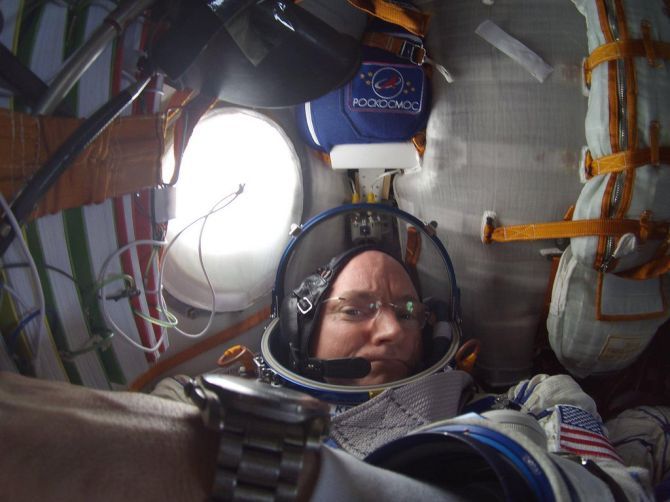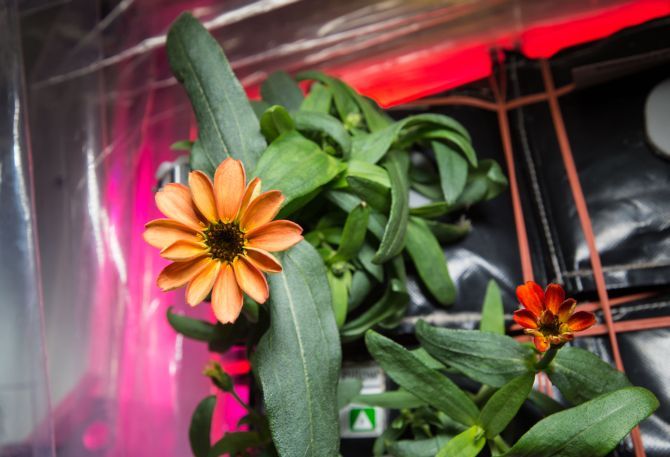 | « Back to article | Print this article |
NASA astronaut Scott Kelly returned to Earth on Wednesday, wrapping up a 340-day-long stay aboard the International Space Station.
It's the longest amount of time an American astronaut has lived in space.
The extended stay was part of the space agency's One-Year Mission, an experiment to see how the human body changes during long-term spaceflight. NASA is eager to send astronauts to Mars someday, and a round-trip mission to the Red Planet is going to be at least two to three years, according to the space agency.
While living in space can be similar in many ways to living on Earth, some things in space are very different.
After a year in space, NASA astronaut Scott Kelly has adapted to a way of life most of us will never experience.
Rediff.com takes a look at the amazing things that Kelly witnessed and had to experience as he hovered over 400 kilometres above the earth zipping around it at 17 thousand miles per hour for nearly an year.
1) I'm taller than you bro!

Scott and his twin brother Mark used to be the same height. However, Scott grew 2 inches during his time aboard the ISS.
"Astronauts get taller in space as the spine elongates," NASA said, "but they return to preflight height after a short time back on Earth."
Though he's no longer an astronaut, Mark volunteered to take part in NASA's ‘Twins Study’ with his brother. NASA wants to see how the identical twins measure up after a year in two very different environments: Scott in space and Mark on Earth.
2) Better than plastic surgery

Scott became 25 microseconds a day younger than his already six-minute-older brother Mark.
Scott Kelly aged faster biologically but he aged more slowly in physical time.
The ISS orbits at about 27,000 km per hour relative to the Earth’s surface. In an effect of Albert Einstein’s special theory of relativity known as the twin paradox, that means time will pass more slowly for Scott than for his brother, to the tune of about 28 microseconds (millionths of a second) a day.
Over 340 days, that’s 8.6 milliseconds -- a little less than a hundredth of a second.
3) Water, water everywhere...

Water’s surface tension doesn’t have to fight gravity in the space station, allowing water molecules to stick together as they float.
When you watch water molecules float in space, you can imagine why astronauts use washcloths to keep clean in space rather than a shower, or why they drink through vacuum seal bags instead of drinking through cups.
Sip on mister.
4) A cup of coffee in the morning!

The ISSpresso machine on the space station was sent up in 2015 and works similarly to a normal espresso machine.
Astronauts hook up two bags, one full of water and the other empty.
The ISSpresso machine dispenses the espresso into the empty bag that astronauts then drink from with a straw.
The good life just gets better in space.
5) The 'fruits' of our labours

Astronauts need to ensure their food doesn’t float away during mealtime.
In addition, they don’t have a refrigerator, so their food is sent up preserved and reheated, similar to food you might take with you on a camping trip.
Unlike on Earth though, astronaut only get fresh fruits and vegetables when a cargo resupply ship arrives or when they can grow it themselves.
Astronauts use Velcro to keep pouches close, and eat tortillas instead of bread because tortillas are less crumbly.
6) Zzzzzzzz....

“Sleeping here is harder here in space than on a bed because the sleep position here is the same position throughout the day,” Kelly said during a Reddit AMA last year.
“You don't ever get that sense of gratifying relaxation here that you do on Earth after a long day at work.”
Before going on his mission Kelly said, “Goodbye bed. I’ll miss your silky smoothness.
7) The roses in my gardens

A blooming zinnia flower in the vegetable plant growth system aboard the International Space Station. Photograph: NASA
When gardening in space, there are a few things you need: plant pillows, wicks and LED lights which help deliver the water and light the plants need in the right amounts at the right time.
This leads to successful lettuce and zinnia growth. But in a controlled environment, astronauts don’t have to worry about insects eating their plants’ leaves!
8) Look at the stars!

While astronauts on the space station can see stars from their vantage point, they often report that their favorite pastime is Earth-gazing.
When Kelly returns, no doubt he’ll get back to what the rest of us do: stargazing. We imagine he’ll also step outside and spot the station as it flies overhead, just like you can!
9) Sunrise, sunset, sunrise, sunset...

The ISS travels at a brisk 17,100 miles per hour. That means it orbits Earth every 90 minutes -- so it sees a sunrise every 90 minutes.
So, every day, the residents of the ISS witness 16 sunrises and 16 sunsets.
In his 340 days in space, Kelly witnessed 10,944 sunrises and sunsets. Down here, we just saw 684.
Damn you space!
10) Walkabout

Going outside for a walk on Earth is relatively safe and easy, and most of us can wander outside for a ramble whenever we want.
Going outside for a walk in space is hard and requires months of preparation and lots of hard work.
In addition, getting into and out of the spacesuit that protects the astronauts in the vacuum of space takes several hours. Stepping out of a spacecraft is inherently dangerous so every move is carefully planned and practiced for months on the ground in advance of an excursion in space.